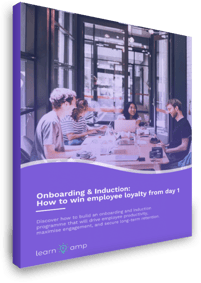If you’re handling the challenging process of building an onboarding programme for hybrid and remote workers, it can be very helpful to look to established remote-first businesses for best practice tips. We’ve rounded some ideas for you to steal here!
Zapier
Zapier is a software development company, with a distributed team that works all over the US and another 36 countries around the world. They’ve been fully remote since 2011, so they know a thing or two about remote onboarding.
1. Onboarding should start well before your new hire starts work“By prepping ahead of time, you make the employee feel valued because you’ve already invested time in them before they officially started. You also avoid wasting people’s time by having a game plan for what the first few weeks look like.”
2. Balance a standardised process with a personalised experienceEvery new hire receives a customised onboarding document. This guide follows a standard template, to make sure nothing is forgotten, but is then modified for each joiner depending on their role.
3. Set them up for successZapier’s onboarding process prioritises getting the new hire to work as quickly as possible, so they can start getting some early wins under their belt. They start assigning small tasks to each new engineer by Day 4, focusing on areas that don’t require a lot of company-specific knowledge but which would benefit from a fresh pair of eyes.
“That early win builds confidence and momentum. It also sets the precedent for the expectation we have of shipping things.”
Buffer
Buffer is a San Francisco-based social media software company. With a team of only 85 people, they have over 73,000 users of their social media management platform, including Microsoft, Trello and Stripe. They started as a hybrid company, shifting effectively to fully remote working in 2015 while maintaining steady business growth.
1. It’s easy to overwhelm new hires with too much informationThis is an issue for every business, but if some of your employees are working from home, you might not even realise they’re struggling until it’s too late. Buffer found that a steady drip-feed of important information was helpful.
Their onboarding process starts before the new hire starts, with 5 emails walking through key details and tools. On the day they start, new joiners receive a copy of a central, standardised onboarding document with a day-by-day checklist of tasks and resources they will need to “establish a solid foundation on the team.” Lastly, each new hire will work with their line manager to develop and commit to a 30-, 60- and 90-day roadmap of goals.
2. Don’t be afraid to iterate.With a major transition like shifting to hybrid work, it’s important to bear in mind that it’s not a one-and-done process. Buffer’s People team are keen to stress that all their processes are conducted like experiments, with a constant cycle of feedback from employees and subsequent iterations.
A platform like Learn Amp can provide you with all the tools you need to quickly and easily collect and respond to employee feedback, with pulse polls, survey templates and much more.
3. Build a buddy system.Buffer’s onboarding process involves not one, but three onboarding buddies. Their hiring manager will make sure the new hire has everything they need. Each new recruit will also have a “role buddy” who can advise them on their specific role and tasks, and a “culture buddy” who can help answer questions about company culture and norms.
Vistaprint
Vistaprint is a multinational printing company, headquartered in the US. Over 20 years in operation, Vistaprint had to make the sudden leap to hybrid work during the first lockdowns in March 2020.
1. Ask for feedback.If you don’t check how your onboarding process works for new hires, you may only realise there’s an issue when they leave!
“One of our remote-first guiding principles has and continues to be requesting extensive input from our team members.”
2. Focus on relationship building.Social integration can be harder in hybrid companies, where some employees never meet others in person. Vistaprint holds a virtual new hire social day so that every team member will feel included, no matter where they work.
During the social day, they’ll play team games like Scattergories and include break-out “rooms” so that the new hire can socialise and build relationships on a one-to-one basis.
Top takeaways from these well-established hybrid businesses
- Start your onboarding process well before Day 1, with careful, well-timed communications – and make sure not to overload your new hires with too much information.
- Find a balance between standardisation and personalisation, and make sure to keep the onboarding process consistent for both remote and in-house staff.
- Ask for feedback and keep iterating and improving your processes as you transition to hybrid work.
Resources:
[1] https://zapier.com/engineering/engineer-onboarding/
[2] https://buffer.com/resources/onboarding/
[3] https://www.comparably.com/news/13-companies-making-remote-onboarding-a-breeze/




